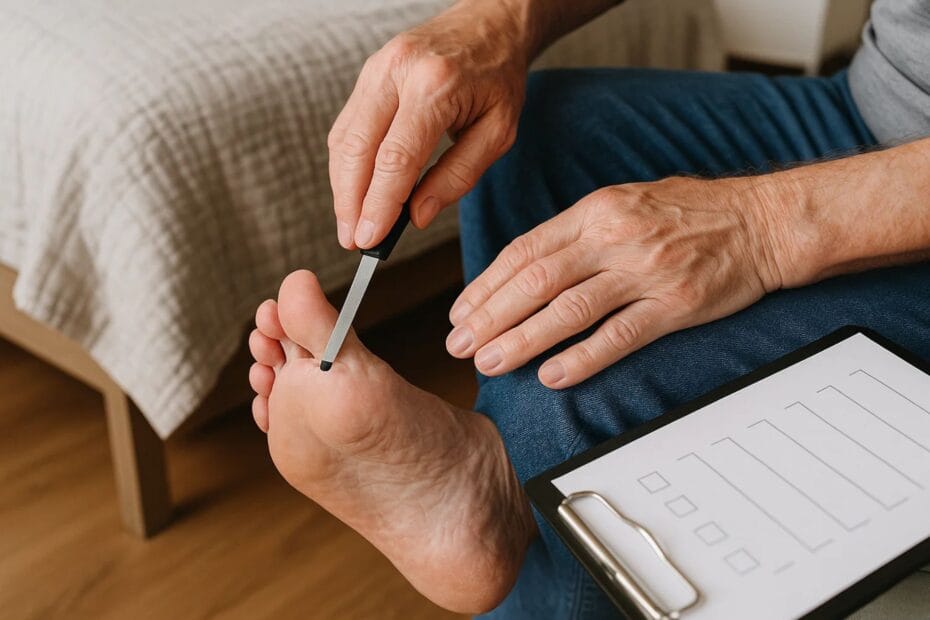Foot wounds and ulcers don’t begin as medical emergencies they start as missed little things: a blister from sandals, a sharp coral edge at the beach, a tiny crack in dry skin. For people with peripheral neuropathy, especially those with diabetes, those “little things” can escalate fast.
This Miami-focused checklist will help you protect your feet year-round, reduce infection risk, and stay active with confidence.
Why neuropathy puts your feet at risk
Damaged sensory nerves reduce your ability to feel pain, temperature, and pressure. That means you might not notice:
- A pebble inside your shoe
- A developing blister from a long walk on Ocean Drive
- A small cut that gets irritated by sweat or sand
Add reduced circulation (common with diabetes, vascular disease, or long-standing neuropathy), and minor wounds can become slow-healing ulcers.
The Miami Foot-Care Checklist
Daily (takes 3–5 minutes):
- Inspect: Use good lighting. Check tops, soles, and between toes. Look for redness, cracks, blisters, calluses, discoloration, or drainage.
- Clean & dry: Wash with mild soap; dry gently, especially between toes.
- Moisturize smart: Apply lotion to tops/soles (not between toes) to prevent cracks that invite infection.
- Sock check: Wear moisture-wicking socks; change after workouts or beach time.
Before leaving home:
- Shoes on always: Even indoors. Step-on sandals can rub; choose supportive sandals with straps or closed shoes that fit properly.
- Shake & check shoes: Make sure there’s no debris inside.
- Fit & feel: Shoes should allow toe wiggle room but not “slosh.” No seams rubbing bunions or hammer toes.
Weekly:
- Toenails: Trim straight across; avoid digging into corners. If vision is limited or nails are thick, see a podiatrist.
- Callus control: Don’t cut calluses. Use a pumice stone lightly after a shower and moisturize.
After beach, pool, or gym:
- Rinse & inspect: Sand and saltwater can hide abrasions; locker rooms can harbor fungi clean and dry well.
- Flip-flop caution: Short trips only. For longer walks, use supportive footwear.
Never:
- Walk barefoot (even at home)
- Use heating pads or hot water soaks (risk of burns if sensation is reduced)
- “Pop” blisters or cut corns/calluses yourself
What if you find a problem?
- Redness/warmth/swelling/pain: Offload pressure (don’t “push through”).
- Open area or drainage: Clean gently, cover with a sterile dressing, and monitor.
- If not improved in 24-48 hours or if you have diabetes seek professional care promptly.
Proactive treatment matters
Foot ulcers are preventable when nerve health and circulation are addressed. Our Miami clinic uses the Dr. Alfonso Neuropathy Treatment Protocol to support nerve function and blood flow with non-invasive technologies and personalized nutrition. Many patients report improved sensation, fewer pressure spots, and better walking tolerance.
Learn how we help:
Learn more Neuropathy Treatment Miami
Book your consultation today: Appointments
Bilingual care – Hablamos español
We serve Miami’s English- and Spanish-speaking communities with clear education, ongoing guidance, and customized care.
Protect your feet. Protect your freedom.
If you’ve noticed numbness, color changes, or slow-healing areas, it’s time for a tailored plan.
📞 305-274-7475 | 📍 8585 Sunset Drive, Suite 104, Miami, FL 33143
Book now: https://www.neuropathyreliefmiami.com/contact/

Sincerely Yours for Health,
Dr. Rodolfo Alfonso, D.C.
8585 Sunset Drive,
STE 104
Miami, FL 33143
Ph: 305-275.7475
www.neuropathyreliefmiami.com/
Call Us For a Complimentary Consultation
Solicita una consulta gratuita con el Dr. Alfonso para saber cómo puedes tratar de forma natural tus síntomas de Neuropatía sin procedimientos invasivos, cirugía ni medicamentos perjudiciales.
Follow us on Instagram, Facebook, and YouTube for updates, patient success stories, and expert insights on neuropathy treatment!
